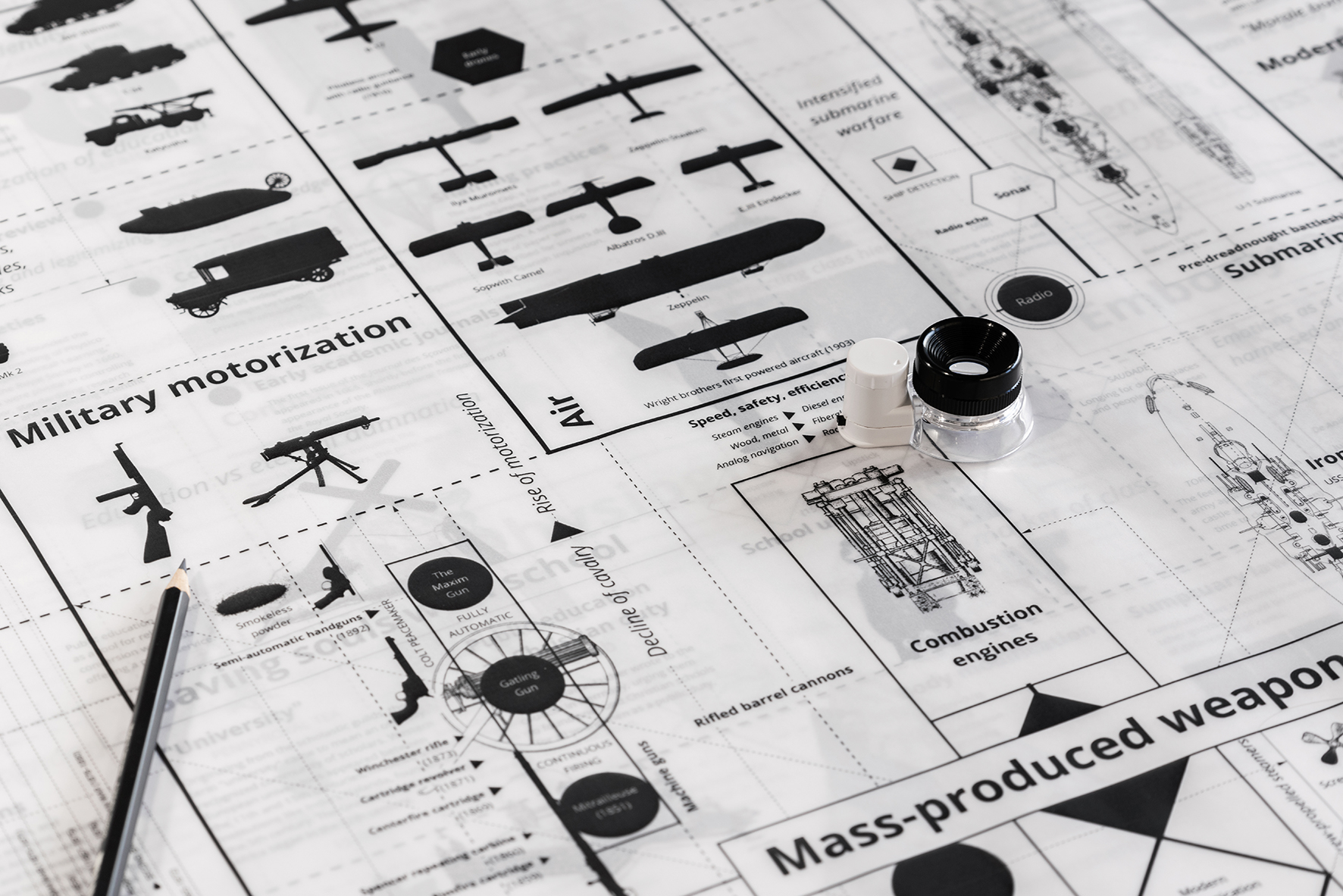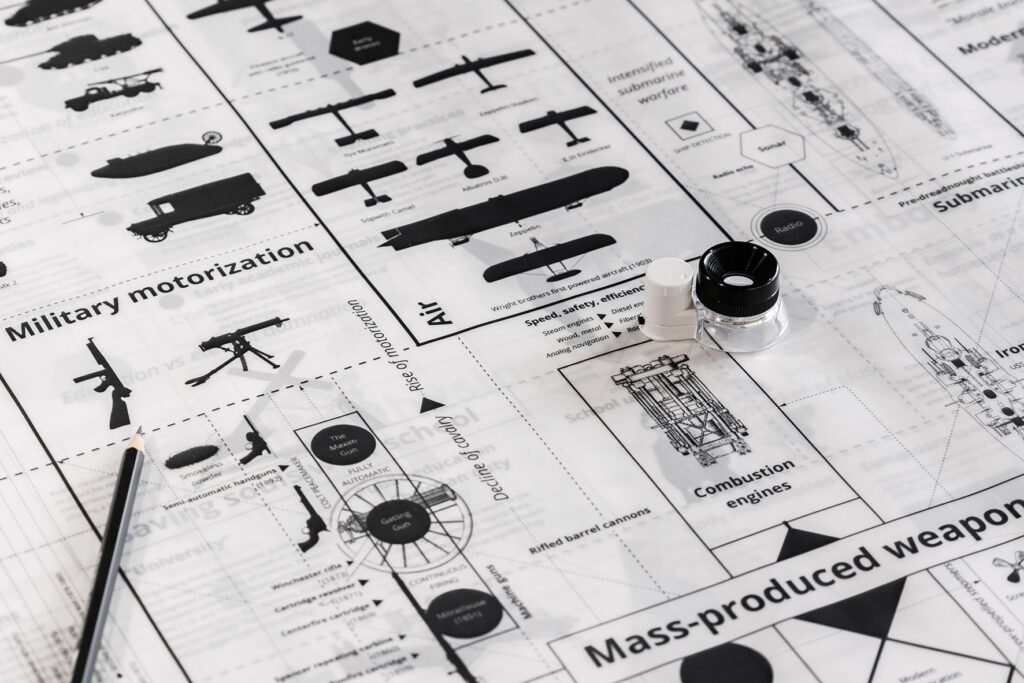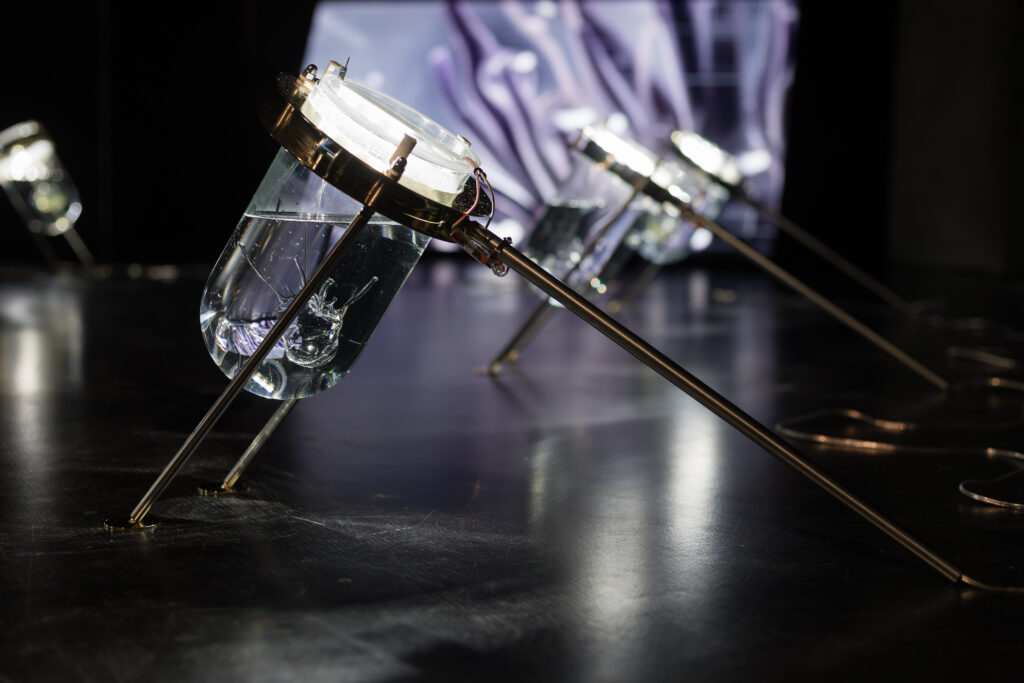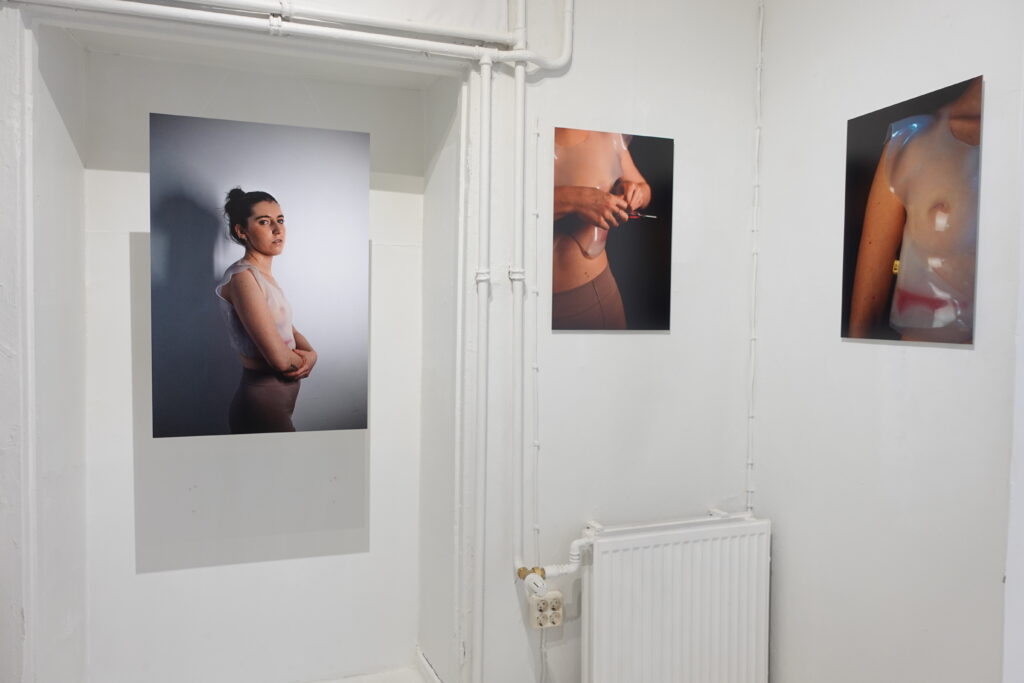- Press release as PDF
- YouTube: Announcement of the winners 2024
- STARTS Prize & Jury 2024
- Winners 2024 including Jury Statements
- Ars Electronica Blog: Interviews with STARTS Prize winners 2024
- Photos via Flickr
- Ars Electronica Festival 2024
(Linz/Brussels, June 24, 2024) 1,308 submissions from 81 countries were received for the European Commission’s STARTS Prize in 2024. At the end of April, the jury met in the Ars Electronica Center in Linz and chose the winners of the two main prizes, each worth 20,000 euros:
The “Grand Prize – Innovative Collaboration” goes to the Arts at CERN program, which promotes collaboration between artists and researchers at the European Nuclear Research Center CERN.
The “Grand Prize – Artistic Exploration” was awarded to the project Calculating Empires: A Genealogy of Power and Technology, 1500-2025 by Kate Crawford (AU) and Vladan Joler (RS). The work examines the entanglement of power, technology, and capitalism over the past 500 years.
Both projects as well as a selection from the 10 Honorary Mentions and 18 Nominations will be presented from September 4 to 8 as part of the Ars Electronica Festival 2024 at POSTCITY Linz.
The European Commission’s STARTS Prize recognizes projects that bring technology and art together in innovative ways and positively influence both the arts sector and European innovation policy. The competition is organized by Ars Electronica.
Jury and selection process
From April 26 to 28, top-class experts came together at the Ars Electronica Center in Linz to evaluate the submissions for this year’s STARTS Prize. The five-member jury consisted of Francesca Bria (IT), Miha Turšič (SI/NL), Fumi Hirota (JP), Manuela Naveau (AT), and Katja Schechtner (AT).
They were supported by the Advisors Amanda Masha Caminals (ES), Yun-Cheng Chen (Lucky) (TW), Primavera De Filippi (FR/IT), Rodolfo Groenewoud van Vliet (NL), Lydia Kallipoliti (GR), Micaela Mantegna (AR), Kyuseung Keith Noh (KR), Irini Papadimitriou (UK), Deborah Rey-Burns (UK/AU), Asako Tomura (JP), and Lining Yao (CN).
S+T+ARTS Prize and S+T+ARTS Initiative
The STARTS Prize is part of the European Commission’s remarkable STARTS initiative, which has funded 189 residencies with €6 million since 2016 and honored a total of 238 STARTS Prize projects. Every year, awards are given to works that combine art, technology, and science in new ways and thus advance economic and social innovations. In the competition, worth 40,000 euros and organized by Ars Electronica, 15,928 projects from 101 different countries were submitted between 2016 and 2023.
The STARTS Prize is supported by a consortium of European partner institutions, which provide the winners with prominent presentation opportunities. In addition to Ars Electronica, the INOVA+ Group, T6 Ecosystems, La French Tech Grande Provence, Sonar, the Salzburg Festival, the TU Dresden, the Media Solution Center Baden-Württemberg, and the High-Performance Computing Center Stuttgart are members of the STARTS Prize network.
The project is funded by the European Union under the Grant Agreement No 101135691. Views and opinions expressed are however those of the author(s) only and do not necessarily reflect those of the European Union. The European Union cannot be held responsible for them.
S+T+ARTS PRIZE ’24
Grand Prize – Innovative Collaboration
Awarded for innovative collaboration between industry or technology and the arts (and the cultural and creative sectors in general) that opens new pathways for innovation.
“Arts at CERN is a pioneering cultural initiative, reflecting CERN’s exceptional openness and experimental spirit. […] Arts at CERN has set a global benchmark for arts-science initiatives, influencing programs in Europe, South Korea, and Australia. It has inspired major initiatives such as the European Commission’s STARTS program and the Joint Research Centre’s sci-art program. In today’s rapidly evolving technological landscape, including advancements in AI, quantum computing, and chip technology, the integration of arts, science, and technology is crucial. Arts at CERN exemplifies how leveraging key scientific and technological infrastructures, multidisciplinary talent, and capacity in Europe can drive innovation and foster a collaborative innovation that truly serve the public interest.”
excerpt from the jury statement
Arts at CERN is the arts program of the European Organization for Nuclear Research in Geneva (CERN), Switzerland. Where physicists and engineers use complex scientific instruments to try to better understand the universe, a sustainable dialogue with artists has been promoted since 2012. The laboratory setting becomes a collaborative field in which theoretical models, mathematical formulas, and artistic approaches are combined.
Arts at CERN explores what art can contribute to basic research and, conversely, how scientific research can inspire art. The aim is to promote artistic reflection of scientific and technological progress and its effects on our world and society; as well as the dialogue between art and science.
In addition, it is about the potential of interdisciplinary collaboration, the reflection of the social structure of science, historical narratives, and special features that make CERN a unique place for artistic research.
Credits
Arts at CERN is supported by the CERN and Society Foundation.
S+T+ARTS PRIZE ’24
Grand Prize – Artistic Exploration
Awarded for artistic exploration and art works where appropriation by the arts has a strong potential to influence or alter the use, deployment, or perception of technology.
Calculating Empires: A Genealogy of Power and Technology, 1500-2025 / Kate Crawford (AU), Vladan Joler (RS)
“By seeing how past powers have calculated, we can begin to calculate the costs of contemporary empires. Calculating Empires thus gives audiences a detailed visual narrative about the relationship between humans, ecologies, and technologies. It traces the ways that technology and power have been entwined over five centuries, through industrialization, imperialism, and automation. It shows how practices of colonialism, militarization, and enclosure operate today and how they might be unwound. It establishes itself as a necessary corrective to the current short-termism in technology criticism and art, which is frequently focused on the most recent spectacles and devices, at the expense of deeper historical and political shifts. Calculating Empires challenges us to redefine our relationship with current socio-technical structures. By asking how we got where we are today, we can (re-)consider where we might be going.”
excerpt from the jury statement
Calculating Empires is a visual manifesto by Kate Crawford and Vladan Joler that critically examines the relationship between technology and power over the past five centuries. It begins its investigation around 1500—a time of upheaval in European history in which printing was invented, scientific instruments were developed, new trade routes emerged, the unscrupulous appropriation of land and the systematic annihilation of indigenous populations began. Kate Crawford and Vladan Joler see the technology and military industries of the 21st century as an echo of these early and ongoing forms of exercise of power and take this as an opportunity to follow developments further.
The result of their meticulous work is a 24 x 3 meter, incredibly complex diagram that traces social power constructions over time. It is designed as a diptych: one half of the visual data preparation focuses on the development of communication devices, infrastructures, computational architectures of algorithms, and hardware. The other half examines the history of control and classification in various areas: in education, in policing, in prisons, in military systems, in the treatment of bodies and biometrics, all the way to the astrosphere.
Together, both maps illustrate how technological and social structures have developed together and supported each other over centuries. The artists break down the traditional representation of the history of technology and show how to “calculate” the present through the lens of the past.
Credits
Calculating Empires: A Genealogy of Technology and Power, 1500–2025
Artists: Kate Crawford and Vladan Joler (2023)
S+T+ARTS PRIZE ’24 – Honorary Mentions
The Echinoidea Future – Adriatic Sensing / Robertina Šebjanič (SI)
Echinoidea Future – Adriatic Sensing investigates biogeological and morphological factors that influence the habitat of sea urchins. The focus is on anthropogenic liquid waste, which leads to low oxygen concentrations in seawater and has serious consequences for biodiversity.
Supported by a range of experts, Robertina Šebjanič has developed a unique coastal exploration that brings together art, technology, and science. The focus is on sea urchins, which are not only an important indicator of environmental pollution but, as herbivorous grazers, are also of great importance for all life forms that live in and on the sediment or rocky bottoms of the sea.
The art installation places experimental setups next to synchronized screens showing environmental data from the EU Copernicus platform from the past thirty years. Transformed by Artificial Intelligence, the data illustrates ecological parameters such as temperature, pH, oxygen and salinity fluctuations in the southern Adriatic. Glass-blown sculptures and the artistic interpretation of microscopic research draw on traditions in art and craft. Experiments highlight the multidimensional narrative of the artworks. Echinoidea Future – Adriatic Sensing not only reveals ecological challenges, but also emphasizes the need for collective responsibility for maintaining the delicate balance of the oceans.
Credits
The Echinoidea future – Adriatic sensing
Artist: Robertina Šebjanič
Production: UR Institute in the frame of STARTS4WATER (S+T+ARTS), 2021/2022
Co-production: Zavod Sektor, Zavod Studio Aquatocene
Production team: I Ivanka Pasalic, David Drolc, Tanja Minarik, Miha Godec, Jakob Grčman
Scientific advisory: Dr. Alenka Malej, Dr. Matjaž Ličer, Gjino Šutić, Filip Grgurević
How (not) to get hit by a self-driving car / Tomo Kihara (JP), Daniel Coppen (GB)
How (not) to get hit by a self-driving car is a game installation that uses self-driving cars as an example to make people aware of how (strongly distorted) training data influences the output of AI systems and that this can sometimes have catastrophic consequences. Tomo Kihara and Daniel Coppen use a cordoned-off piece of road or parking lot as a playing field; they apply the characteristic white stripes of a cross walk to the asphalt. The players start at one end of this cross walk, opposite them, and on the other side of the street there is a truck parked with a huge screen that shows the perspective of an AI-controlled camera. As soon as the players enter the cross walk, they are captured by the camera and can be seen on the screen. While people try to cross, the AI system calculates the probability that it is a pedestrian. If the players are recognized before they get to the other end of the street, the machine wins, if not, it loses. Whether with a traffic cone on their head, hidden behind a stroller or crawling on the ground—if the players want to remain “invisible” to the AI system, they must not match the patterns of its training data.
Credits
Music: Plot Generica
Support: Saki Maruyama (Playfool)
Photography: Luke O’Donovan, Playable City Bristol July 2023; Daniel Coppen
Videography:
Jon Aitken, Playable City Bristol July 2023
Jack Offord, Playable City Bristol July 2023
Jacob Gibbins, Playable City Bristol July 2023
Daniel Coppen, Playfool
Commissioned by: Playable City Sandbox 2023 supported by MyWorld
Korallysis / Gilberto Esparza (MX)
Korallysis is a hybrid organism that allows technology and coral colonies to coexist in a mutualistic relationship. Korallysis is made from ceramic segments whose geometric structure adapts perfectly to the nature of the seabed and creates an ideal habitat for corals. Kinetic elements use water movement to generate electricity for electrolysis, which binds minerals dissolved in salt water, such as calcium carbonate, to the ceramic surface. These minerals, in turn, promote coral growth.
Korallysis is a research platform at the interface of art, science and technology to promote the restoration of coral reefs, which are not only of great importance as CO2 storage, but are also habitat for countless marine species and therefore indispensable for maritime food chains. With Korallysis, Gilberto Esparza and his colleagues want to raise awareness of how important it is to protect coral reefs. They therefore propose new forms of relationship between people and nature, based on collaboration and interdisciplinary teams and involving local communities.
Credits
Production and technical support: Taller30, Ale Mendoza, Michel Abrão, Yorick Bekker, Andrea Rassel
Collaboration: Centro Regional de Investigación Acuícola y Pesquera-CRIAP Manzanillo del Instituto Nacional de Pesca y Acuacultura – INAPESCA, Mexico; Ejidal Cooperative Society Tenacatita MX; Restore Coral AC; Oceanus AC
With support from: Goethe Institut / Prince Claus Fund for Culture and Development, Sistema Nacional de Creadores de Arte de México, Estímulos Fiscales para las Artes EFIARTES
Mapping Uncertain Landscape: The Satellite / Sofia Isupova (UA)
Mapping Uncertain Landscape: The Satellite examines relationships between humans and machines, between cartographers and their maps. Our modern remote sensing infrastructures and the resulting maps and mapping processes are examined. The project focuses on the changes in the Ukrainian landscape that are a direct result of daily fighting.
Sofia Isupova has constructed a device that transfers data from the commercial satellite “EOS SAT” onto long rolls of paper. In the colors green, yellow, and red, the machine draws trees, fields, and hedges on the paper, making it visible where the vegetation is diverse, where it is destroyed and robbed of its diversity.
Together with ecologists and geoscientists, Sofia Isupova has created countless maps that visualize landscape changes as a direct result of acts of war such as the first Russian offensive on Kiev or the destruction of the Kakhovka Dam.
Credits
Diploma project for the Department of Space and Communication at HEAD Geneva
Tutor: Dominic Robson
Music: Aleyna Günay
With support from: HEAD Geneva, Kyiv Emergency Art Platform, EOS Data Analytics Academic Outreach Program
Maria CHOIR / Maria Arnal Dimas (ES)
Maria CHOIR is an immersive installation that invites real-time interaction with an AI system to explore the limits of singing and listening. The AI system, trained with the voice of Spanish singer Maria Arnal, gives users the opportunity to join in a unique duet. Presented in a dark, intimate room, the installation on a transparent base reveals its inner workings. Loudspeakers envelop users in a multi-layered sound fabric. An AI-animated avatar guides users, transforming based on their voice input and creating a personalized, ever-changing experience.
Maria CHOIR is not just an artistic experiment, but a social experience around new live musical tools, AI, and collective data sets—it demonstrates the potential of synthetic voices that goes beyond mere imitation of human capabilities. Furthermore, it invites you to contribute to a collective language model used for both artistic and research purposes. Maria CHOIR aims to demystify AI technology, promote collaborative creativity, and explore the explainability of AI through music.
Credits
Concept, direction and music production: Maria Arnal
Funding and support: Fundación Española de Ciencia y Tecnología (FECYT)
Technical execution and programming: Barcelona Supercomputer Center (BSC), axolot.cat (Iván Paz and Lina Bautista)
Interactive design: axolot.cat (Iván Paz and Lina Bautista)
Visuals and artistic design: JP Bonino
Curator: Lluís Nacenta
Host and exhibition space: Centre de Cultura Contemporània de Barcelona (CCCB)
With support from: Fundación Española de Ciencia y Tecnología (FECYT)
METABOLICA / Thomas Feuerstein (AT)
METABOLICA opens the “factory of life”, makes an ecological production and recycling cycle visible, and tells a story of change from the industrial revolution to the present and future; from whaling and petromodernity to current and future scenarios in biochemistry.
In METABOLICA, bacteria act as artistic actors by “metabolizing” fatty acids enriched in algae into PHB (polyhydroxybutyrate), a biodegradable plastic from which sculptures can be created. This cycle is made possible by various stations that perform different tasks—from growing the algae and forming the fatty acids, to PHB conversion, cleaning and drying the biomass to processing the powder with a 3D printer. While previously the material for sculpture came from a quarry like Carrara and the chisel was used as a tool, in METABOLICA living organisms are used.
METABOLICA was launched in 2017 and has been supported by a team of scientists and engineers since 2020. The aim of the research is to use carbon sources from wastewater streams in industrial and sewage treatment plants to produce PHB.
Credits
Artist: Thomas Feuerstein
P2P / Eva & Franco Mattes (IT, US)
Inspired by a speculative project by architect Rem Koolhaas, who wanted to integrate a museum into a data center, P2P conversely brings a data center into the museum. This highlights and celebrates peer communities created by artists who have used the Internet over the last 20 years to share their work and knowledge.
The central element of the installation is a server in a mesh cage, which is connected to the peer-to-peer network via the infrastructure of the hosting art institution. He shares new or rarely seen digital artworks by artists such as Nora Al-Badri, Simon Denny, Do Not Research, Olia Lialina, Jill Magid, Jon Rafman, and Vladan Joler.
P2P makes visible an infrastructure that houses our data but is normally hidden from us. Unlike traditional servers, peer-to-peer networks store data in a decentralized manner. They are anonymous and free from commercial interests, data analysis and monitoring. Participants (“peers”) connect their computers to the system and share resources such as files, bandwidth, and computing power. Since public art institutions mostly focus on preserving paintings or sculptures and do not invest in digital artifacts, P2P seeks and opens up new opportunities for the distribution and preservation of digital works: by hosting these works, a public institution directly contributes to the distribution and preservation of art on the Internet.
Credits
P2P, 2020, by Eva & Franco Mattes
Cage, cabinet, rack server, files, Torrent software, internet connection, neon lights
312 x 209 x h208 cm
Installed at Frankfurter Kunstverein
With support from: Frankfurter Kunstverein; KW Institute for Contemporary Art, Berlin
Self-Care / Lyndsey Walsh (US)
Self-Care is a multimedia artwork and installation that critically examines the concepts of care, work, trauma, and the effects of gender binary in healthcare. The focus is on the pursuit of bodily autonomy rather than genetic fatalism and a neoliberal health agenda.
“Chest binders” are used—sometimes by trans* people or non-binary people—to flatten the female breast. Lyndsey Walsh uses such a garment to wear live breast cancer cells that match their own genetic makeup directly on the body. Lindsey Walsh takes care of the cells before medical interventions are rigorously applied. Self-Care explores the state between sick and not-sick; explores the hopes, successes, and failures that arise from attempting to “live” with a body and its flaws.
In parallel to the self-experiment, video works entitled Mommagraphy Techniques and A Letter to My Mother were created, which convey experiences with the topics of health and gender across four female generations.
Credits
Artist: Lyndsey Walsh
Commissioned by: Bioart Society for “m/other becomings” program
Production: Bioart Society and Art Laboratory Berlin
Mommagraphy Techniques Video: Interview with artist’s mother and remixed footage from US National Institute of Health (public domain)
Self-Care portrait photography: Pavlina Belokrenitskaia
Scientific collaboration and support: Prof. Dr. Peter Hegemann, Dr. Johannes Oppermann, Enrico Schiewer, Dr. Olga Baidukova, and Prof. Dr. Kristiina Aittomäki.
Incubator: Collaboration between Lyndsey Walsh & Petteri Haverinen
Photo documentation: Asya Kaplan, Genietta Varsi, Milla Millasnoore, and Tim Deussen
Concept research: Prophylaxis project by Lyndsey Walsh with Art.ITMO.Reisdency
The Waterworks of Money / Carlijn Kingma (NL)
Although money plays a key role in our lives, the workings of our financial system are a mystery to most people. The Waterworks of Money demystifies the world of big finance by visualizing the flow of money through our society. It explores several options for improvement using new technologies—with the ultimate goal of designing the best money system possible for the digital age.
The project is a collaboration of cartographer Carlijn Kingma, investigative journalist Thomas Bollen and professor of New Finance Martijn van der Linden. Kingma spent 2,300 hours drawing a map of the money system, based on in-depth research, partnerships with financial institutions, and interviews with more than 100 experts: executives and employees of (central) banks and pension funds, and asset managers, politicians, academics and monetary activists.
Designing the money system—and the laws and institutions that govern it—is ultimately a democratic task. In practice, however, there is a major obstacle impeding the democratic process: financial illiteracy. By making the world of money understandable, The Waterworks of Money helps citizens to develop their own vocabulary to participate in the debate about the future of our money.
Credits
Drawings: Carlijn Kingma
Stories: Thomas Bollen, Carlijn Kingma, and Martijn Jeroen van der Linden
Animations: Studio Tiepes
English translation: Erica Moore
Audio recordings: Studio Oorbit
Photos: Studio Oppa
With support from: The Hague University and investigative journalism platform Follow The Money; Stimuleringsfonds Creatieve Industrie; Stichting Brave New Works; and the Interledger Foundation. The project received support from the Rabobank through an artist-in-residence.
VRJ Palestine / Nisreen Zahda (PS)
The VRJ Palestine (Virtual Reality Journey to pre-Nakba Palestine) initiative explores the potential and challenges of Virtual Reality tools to virtually reconstruct villages destroyed in the 1948 Palestine War. The aim is to preserve cross-generational memories of the events and places of that time through stories and photos. Nisreen Zahda attaches great importance to innovative documentation tools, as new digital narrative worlds open up multi-sensory experiences to experience history. The project makes it possible to archive memories of destroyed places and make them newly accessible to others. It is aimed at preventing the loss of historical knowledge, which threatens with the death of the last survivors of the Nakba. While archives are often reserved exclusively for scientific purposes, with VRJ Palestine the artist addresses the public.
VRJ Palestine uses a layered approach that combines archival data to create an interactive environment rendered in real time. This makes a virtual journey possible, during which you can immerse yourself in reconstructed rooms and memories. The final product is designed for use on various VR platforms, including WebVR tours and immersive VR experiences. VRJ Palestine includes several projects, including the reconstruction of villages such as Tantoura, Hittin, Zirin, and parts of Jaffa city. The Jaffa Flashbacks project was submitted for the STARTS Prize 2024 and was published in 2023 and enables a WebVR experience on a variety of digital devices, including smartphones.
Credits
Artist: Nisreen Zahda
Statements
“Technology has become the determining factor of our time; it presents us with major challenges. The projects honored at this year’s STARTS Prize address these challenges and explore how we can find an economically, ecologically and socially sustainable approach to these technologies. The focus is not on economic profit interests, but on finding concrete solutions to the pressing problems of this 21st century.”
Klaus Luger, Mayor of the City of Linz and & Owner Representative of Ars Electronica
“The STARTS Prize received 1,308 submissions from 81 countries this year. An exclusive selection will be presented in September as part of an exciting exhibition at the Ars Electronica Festival. Anyone who still has doubts about whether the interaction of art, technology, and science can contribute to a better future should definitely visit this exhibition. Anyone who sees great potential in it should, of course, also visit this exhibition.”
Doris Lang-Mayerhofer, City Councilor for Culture, Chair of Ars Electronica’s Supervisory Board
S+T+ARTS PRIZE ’24 – Nominations
AUTOPOIESIS / ATELIER-E (DE)
Credits
Audio visual installation: ATELIER-E
Studio assistance: Aaron Schwerdtfeger
Curation: Dr. Anett Holzheid, Sarah Donderer, Nina Liechti, Beatrice Zaidenberg
Neuroscientific consulting: Ravi Kanth Kosuru, Dr. Mathias Vukelic
Co-production: ZKM | Center for Art and Media Karlsruhe
The artistic research project AUTOPOIESIS is realized in collaboration with Fraunhofer Institute for Industrial Engineering IAO, IAT of the University of Stuttgart and the media artists of ATELIER-E Produced in cooperation with ZKM | Center for Art and Media Karlsruhe.
Bibliokepos / Nomad Garden (ES)
Credits
Promoters: ICAS – Seville City Council; Municipal Network of Libraries of Seville; Chair of Climatic Comfort of the University of Seville; ETSAS & fablab Sevilla; Ecosistema 41
Creators: A. Jiménez, JM. Sánchez-Lauhle, M. Hernández, R. Herrera, E. Mayoral, M. Carrascal, 14:30studio, J. Navarro, P. Pujol, Bosque Anxanar, Cuarteto Con Fuoco, J. Vila.
Production: El Mandaito
Communication: Surnames
Idea and curatorship: Nomad Garden
Botto / Botto Project (The internet)
Credits
Art Engine: Mario Klingemann (a.k.a. Quasimondo)
App and DAO: ElevenYellow
Tokenomics: Carbono
Art Advisory: Colección SOLO
Governance: BottoDAO
Clay PCB
Eco-Feminist Decolonial Hardware / Patrícia J. Reis (PT/AT), Stefanie Wuschitz (AT)
Credits
Concept and design: Patrícia J. Reis & Stefanie Wuschitz
PCB Design: Patrícia J. Reis & Daniel Schatzmayr
3D Printing: Klemens Kohlweis
Clay research: Patrícia J. Reis
Destination Earth / Salomé Bazin (FR)
Credits
Artist: Salomé BazinComposer and generative music: Rob M Thomas
Creative technologist: Sebastiano Barbieri
With support from:Emil Banca, IFAB; Part of GRIN S+T+ARTS residency
FORMATA / PЯОТO-ALIEИ PЯOJECT (JP)
Credits
Experimental laboratory: Gifu Prefectural Industrial Technology Center
Rock design: Yasushi Inoue
With support from: The Institute of Advanced Media Arts and Sciences (IAMAS); The Department of Information Design, Tama Art University; The Graduate School of Arts and Sciences, The University of Tokyo
Godmode Epochs / dmstfctn (UK)
Credits
Developed by dmstfctn
Music: Hero Image
With support from: Alan Turing Institute’s Public Engagement Grant 2022; Serpentine Galleries’ Arts Technologies Programme, and Serpentine’s Creative AI Lab; Center for Postidigital Cultures, Coventry University.
GR-AI-N
Marielena Papandreou (GR)
Credits
VOJEXT S+T+ARTS Art Residence 2: Robotics in Arts and Crafts received funding from the European Union’s Horizon 2020 research and innovation program under the Grant Agreement no.952197.
Residence led by VOJEXT PARTNERS: Robotnik and WAAG
Collaborative partner: Vincent Huyghe
With support from: TMDC, an open-access workshop in Barcelona, offered space and manufacturing facilities.
IAAC in a generous gesture provided a UR10 for a preliminary testing of the scanning workflow before the mobile platform’s arrival in Barcelona.
Low Carbon Chinatown / Ling Tan (SG/UK)
Credits
Low Carbon Chinatown is a project by Ling Tan, originally commissioned by Kakilang
Narrative Futures: Panchatantra Fables meet Personal Primer / Daniel Devatman Hromada (SK), DigiEduBerlin (M)
Major contributions: Nikoloz Kapanadze, Hyungjoong Kim; with support from the late Professor Joachim Sauter
Nishikigoi NFT / Toshi (JP)
Credits
Co-founder: Yamakoshi Public Meeting; Crypto Village
Generative artists: Okazz, raf, ykxotkx
Prometheus Firebringer / Annie Dorsen (US)
Credits
Writer, director, performer: Annie Dorsen
Sound design: Ian Douglas-Moore
Video and systems design: Ryan Holsopple
Lighting design, technical direction: Ruth Waldeyer
Software design and programming: Sukanya Aneja
Voice prints: Okwui Okpokwasili, Livia Reiner
3D artist: Harry Kleeman
Dramaturgy: Tom Sellar
Producer: Natasha Katerinopoulos
Original support was provided to Bryn Mawr College by The Pew Center for Arts & Heritage, Philadelphia. Additional support from New York Live Arts’ Live Feed Residency Program, Partners for New Performance, Media Art Xploration’s MAXmachina laboratory (funded by Science Sandbox), the Eureka Commissions program by Onassis Foundation, and the Mercury Store.
Revolution Refridge / Rojava Center for Democratic Technologies (SY) and Dani Ploeger (NL)
Credits
Rojava Center for Democratic Technologies (Basil, Ciwana, Dani, Khalil, Siham)
With support from: University of Rojava (Qamishlo, Autonomous Adminstration of North and East Syria), The Royal Central School of Speech and Drama (University of London, UK)
Sentient Clit: the Pussification of BioTech / Jiabao Li (CN), WhiteFeather Hunter (CA)
Credits
Jiabao Li, WhiteFeather Hunter
Lera Niemackl collaborated in initial experimental phases of the project by providing tissue culture support to Jiabao Li, as well as co-authoring the ISEA 2024 conference proceedings. Cell differentiation guidance and material support were provided to WhiteFeather Hunter by Stuart Hodgetts and Guy Ben-Ary, UWA. Videographer (for Jiabao Li): Teresa Nichta.
WhiteFeather Hunter received research and exploration funding from the Canada Council for the Arts and the Conseil des arts et des lettres du Quėbec. Jiabao Li received funding support from the University of Texas at Austin, Effie Marie Cain Regents Chair in Fine Arts.
Soft Collision / Anna Schaeffner (FR)
Credits
Artist: Anna Schaeffner
VOJEXT S+T+ARTS Art Residence 3: Social Robots
Solar Protocol / Tega Brain, Alex Nathanson, and Benedetta Piantella (M)
Credits
Solar Protocol is by Tega Brain, Alex Nathanson, and Benedetta Piantella
Project contributors and stewards: Anne Pasek, Caddie Brain, Brendan Phelan, John Samoza, Camilo Rodriguez Beltran, Daniel Ñuñez, Alejandro Rebolledo, Graham Wilfred Jnr, Tim Chatwin, Bridgit Chappell, Baoyang Chen, Denzel J. Wamburu, Cyrus K, Chris Stone, Jesse Li, Zoë Horsten, Jarl Schulp, Crystal Chen, and Jonathan Dahan
With support from: Eyebeam Rapid Response for a Better Digital Future program, Code for Science & Society’s Digital Infrastructure Incubator, and a Mozilla Creative Media Award
The Russian Airstrike on the Mariupol Drama Theater / The Center for Spatial Technologies
Credits
This study is conducted by the Center for Spatial Technologies (CST) in collaboration with Forensis & Forensic Architecture. We were working with numerous external contributors to make this project happen.
Core CST team: Maksym Rokmaniko, Mykola Holovko, Daryna Vilkhova, Ksenia Rybak, Valeria Prorizna, Andrii Onyshchenko, Oksana Hrabchak, Sasha Zakrevska, Natasha Pereverzina, Herman Mitish, Orest Yaremchuk
The Urban Biotope / Vasily Sitnikov (RU)
Credits
Technical assistance: Francesco Niederhauser, Tobias Hartmann, Sahra Khan, Sara Graf, Elena Kitani, Ming-Yang Wang, Girts Apskalns
With support from: Benjamin Dillenburger, ETH Zurich, HOLCIM Switzerland, Swiss Nasional Scientific Foundation (SNSF)
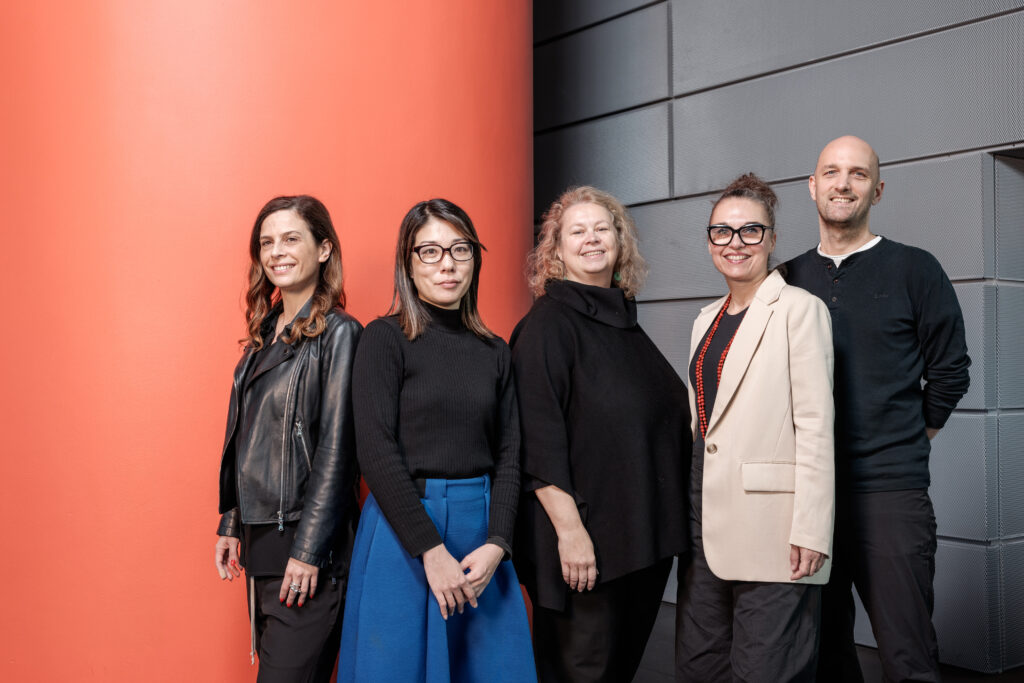
Jury S+T+ARTS Prize (2024)
Photo showing (left to right): Francesca Bria, Fumi Hirota, Katja Schechtner, Manuela Naveau, Miha Turšič
Photo: vog.photo
